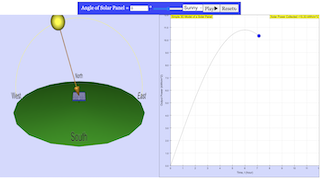Translations
| Code | Language | Translator | Run | |
|---|---|---|---|---|
 |
||||
Software Requirements
| Android | iOS | Windows | MacOS | |
| with best with | Chrome | Chrome | Chrome | Chrome |
| support full-screen? | Yes. Chrome/Opera No. Firefox/ Samsung Internet | Not yet | Yes | Yes |
| cannot work on | some mobile browser that don't understand JavaScript such as..... | cannot work on Internet Explorer 9 and below |
Credits

lookang; coco; with inputs from Singapore University of Technology and Design (SUTD)
Sample Learning Goals MOE’s Eco Stewardship Programme
- Sunlight is a promising renewable energy resource for Singapore.
- Sunlight is one of Singapore’s four national “switches” (natural gas, solar, regional power grids, emerging low-carbon alternatives)
- The lack of space for deployment due to Singapore’s small size and the intermittency of sunshine due to cloud cover and urban sharing are some challenges associated with solar panels
- Scientists and engineers are constantly innovating to overcome these limitations so that solar panel deployment is more viable for Singapore
For Teachers
**Introduction:**
In an era where sustainability and renewable energy are at the forefront of global discourse, innovations in solar technology are paving the way for a brighter, cleaner future. One such advancement comes in the form of an enhanced solar panel simulation, revolutionizing the way we understand and utilize solar power. Join us as we delve into the intricacies of this cutting-edge simulation and explore its potential to reshape the renewable energy landscape.
**Unveiling the Next Generation:**
Imagine a virtual environment where solar panels come to life, their photovoltaic cells gleaming under the sun's radiant rays. This improved simulation transcends traditional models, offering a dynamic and immersive experience that mirrors real-world conditions with unprecedented accuracy. Gone are the days of static data points and simplistic representations – our simulation harnesses state-of-the-art technology to deliver a true-to-life depiction of solar energy production.
 |
| catalogue direct link |
**Key Features and Enhancements:**
1. **Real-Time Performance Monitoring:** Witness the performance of your solar panels unfold in real-time, with detailed metrics tracking energy output, efficiency, and environmental factors. Gain valuable insights into how variations in sunlight intensity, panel orientation, and shading (from combobox, sunny, cloudy, rainy and real data to study the impact on overall performance.
 |
| simulated day with sunny, cloudy and rainy all in one day catalogue direct link |
 |
| rainy day with low "incident intensity of sunlight on the solar panel (kW/m²)" catalogue direct link |
 |
| cloudy with middle level of "incident intensity of sunlight on the solar panel (kW/m²)" catalogue direct link |
2. **Interactive Optimization Tools:** Empower yourself with tools to optimize solar panel placement and configuration. Experiment with different tilt angles, azimuths, and array designs to maximize energy generation and minimize losses. Our intuitive interface makes it easy to fine-tune parameters and visualize the impact on system performance.
 |
| different tilt angles |
3. **Advanced Environmental Modeling:** Dive deeper into the intricacies of solar irradiance and atmospheric conditions with advanced environmental modeling. Our simulation incorporates factors such as cloud cover, sun declinationAngle = (23.45*pi/180) * Math.sin( (360/365)*(284+day) ) and geographic location (Singapore is 1 degree North thus not coded in) to provide a comprehensive understanding of solar energy dynamics.
**Applications and Impact:**
The applications of this enhanced solar panel simulation are far-reaching, spanning across industries and sectors. From renewable energy enthusiasts and homeowners seeking to harness solar power for their households to policymakers and urban planners shaping the future of sustainable cities, the simulation offers invaluable tools for informed decision-making and strategic planning.
**Conclusion:**
As we stand on the precipice of a renewable energy revolution, the importance of innovative technologies like the enhanced solar panel simulation cannot be overstated. By providing a dynamic platform for experimentation, analysis, and optimization, this simulation empowers individuals and organizations to unlock the full potential of solar energy. Together, let us embrace the promise of a cleaner, greener future and embark on a journey towards a sustainable tomorrow.
**Join us as we unveil the future of solar energy – one simulation at a time.**
Introduction:
In an era where sustainability and clean energy are at the forefront of global conversations, harnessing the power of the sun has become a key focus. Solar panels, also known as photovoltaic (PV) panels, are instrumental in converting sunlight into electricity. But did you know that the efficiency of these panels can be significantly enhanced by adjusting the tilt angle to maximize exposure to sunlight?
Understanding Solar Panels:
Solar panels are devices that capture sunlight and convert it into electricity through the photovoltaic effect. This process involves the interaction of photons (light particles) with semiconductor materials, generating an electric current. The electrical energy produced by solar panels can be utilized to power homes, businesses, and even entire communities.
To visualize and understand the impact of tilt angle on solar panel performance, an interactive model facilitated by Easy JavaScript Simulation (EJSS) allows users to simulate the positioning of solar panels at various tilt angles and observe the corresponding changes in power output. This hands-on approach helps users grasp the significance of tilt angle optimization in harnessing solar energy efficiently.
Within the interactive simulation, users can click the "play" button to initiate a simulated timeline that mirrors the sun's journey from east to west. This feature allows individuals to witness in real-time how the graph captures the fluctuating output power over the day. Users can actively experiment with the tilt angle during this time. By adjusting the tilt angle while the simulation is in motion, users can observe the immediate effects on power output, providing a hands-on experience that enhances understanding and appreciation for the significance of tilt angle optimization in solar panel performance. It's an educational journey that brings the complexities of solar energy conversion to life.
- Increased Energy Production: Proper tilt angle optimization can lead to increased exposure to sunlight, resulting in higher energy production by solar panels.
- Seasonal Adaptability: Adjusting the tilt angle allows for seasonal adaptation, ensuring optimal energy generation throughout the year.
- Financial Savings: Maximizing power output means more efficient use of solar energy, potentially leading to reduced electricity bills and increased cost savings.
Factors affect electrical energy such as Weather Cloudy Rainy etc
Research
Activity 1: Energy output from a solar panel
- A solar panel contains multiple solar cells.
- Each of these cells generate electricity from light.
- This process is called the photovoltaic effect.
- Several factors determine how much electricity a solar panel can generate.
- Click on the link below to explore the solar panel simulation.
- Adjust the controls such as "Angle of Tilt of the Solar Panel" to see how the different variables affect the output of the solar panel
Activity 2: Deploying solar panels in Singapore
-
When you used solar panel simulation, you would probably have realised that:The amount of energy obtained from solar panels for generating electricity is not consistent. It is dependent on several external factors such as
- day of the year
- the angle of tilt of the solar panel
- the availability of direct sunlight, example 6am to 6pm daytime
- the weather such as sunny, rainy or cloudy
as you explore the simulation, check that these externl factors can be observed.Intermittent energy resource
Since the amount energy available from the Sun is NOT consistent, we say that sunlight is an intermittent energy resource.Intermittency is one of the reasons why sunlight is currently not the main contributor for electricity generation in Singapore. -
Video
https://www.youtube.com/watch?v=I6qU9PP3e14&t=2s
https://www.youtube.com/watch?v=stOYMwxSWlE&t=17s
Version:
- https://weelookang.blogspot.com/2024/02/harnessing-power-of-sun-exploring-solar.html
- https://weelookang.blogspot.com/2024/04/unveiling-future-enhanced-solar-panel.html
- https://vle.learning.moe.edu.sg/moe-library/lesson/view/990b330b-8e05-4fb1-b35f-fd5024ebade8/cover Sec Science
- https://vle.learning.moe.edu.sg/moe-library/lesson/view/990b330b-8e05-4fb1-b35f-fd5024ebade8/cover Pre-U
Other Resources
[text]
end faq
{accordionfaq faqid=accordion4 faqclass="lightnessfaq defaulticon headerbackground headerborder contentbackground contentborder round5"}
- Details
- Written by Coco Lee
- Parent Category: 04 Energy & Fields
- Category: 07 Energy Work Power
- Hits: 1029













